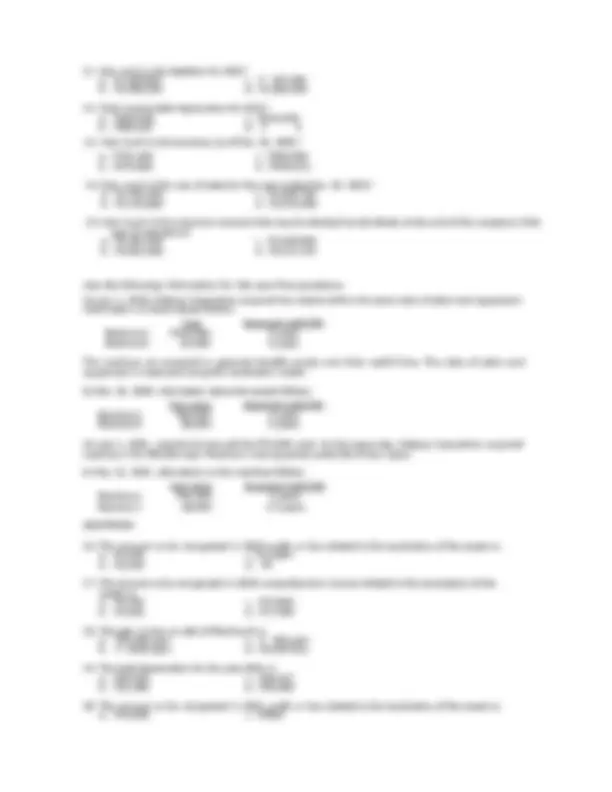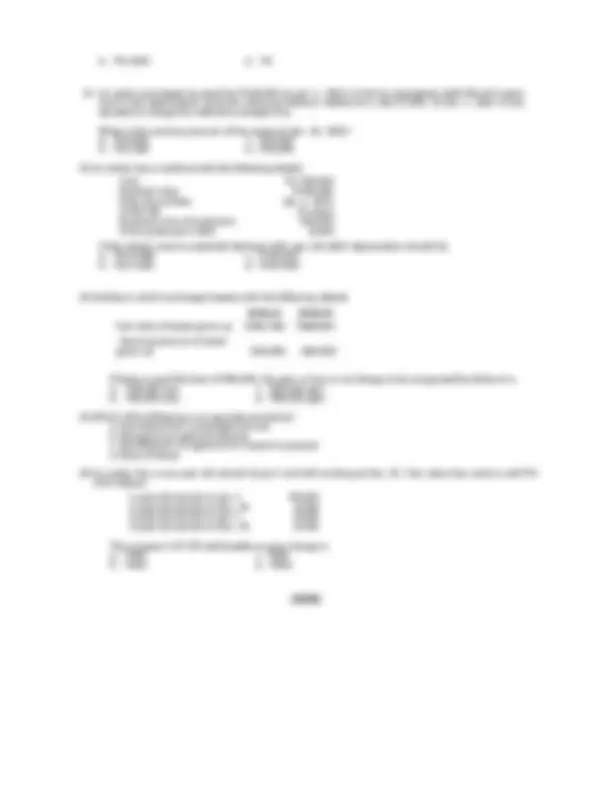Intermediate Accounting 3
Assessment Quiz
1.
During 2021, an entity constructed a new manufacturing facility. The weighted average expenditures
for 2021 were calculated to be P8,500,000. The entity had the following debt outstanding at Dec. 31,
2021:
7 percent, five-year note to finance construction of the manufacturing facility, dated Jan. 1, 2021,
P6,000,000.
5 percent, 10-year bonds issued at face value on July 1, 2018, P10,000,000. The bonds were issued
to finance the construction of an administrative building completed in 2020.
8 percent, six-year note payable, dated June 30, 2020, P5,000,000.
Determine the amount of interest to be capitalized by the entity for 2021.
a. P534,650 c. P595,000
b. P570,000 d. P620,000
2.
Which of the following borrowing costs qualify for capitalization?
a.
Borrowing costs incurred while land is under development during the period in which activities
related to the development are being undertaken.
b.
Borrowing costs incurred w hile land acquired for building purposes is held without any
associated development activity.
c. Borrowing costs during an extended period in which
the entity suspends the activities necessary
to prepare an asset for its intended use or sale.
d.
None of these.
3.
An asset is being constructed for an entity’s own use. The asset has been financed w ith a specific
new borrowing. The interest cost incurred during the construction period is
a. A part of the historical cost of acquiring the asset to
be written off over the estimated useful life of
the asset
b. A prepaid asset to be written off over the estimated
useful life of the asset
c.
A part of the cost of the asset to be written off over the term of the borrowing
d. Interest expense in the construction period
4.
In relation to a grant that becomes repayable, which of the following will result in an amount
recognized immediately in profit or loss?
a. Repayment of a grant related to an asset accounted
for as a deferred income.
b.
Repayment of a grant related to income when the unamortized deferred credit is more t han the
amount repayable.
c.
Repayment of a grant related to income when the
unamortized deferred credit is less than the
amount
repayable.
d.
None of these.
5.
Which statement is correct regarding government grants?
a.
Government grants include free technical or marketing advice.
b.
Grants related to income are government grants whose primary condition is that an entity
qualifying for them should purchase, construct or otherwise acquire long-term assets.
c.
A government grant that becomes receivable as compensation for expenses or losses incurred
in a previous period shall be recognized in profit or loss of the period in which it becomes
receivable.
d.
An entity need not disclosed unfulfilled conditions
and contingencies attaching to recognized
grants.
6.
Entity C accounts for non-current assets using the revaluation model. On Oct. 1, 2021, it classified
an
equipment as held for sale in accordance with PFRS 5. At that date the asset’s carrying amount was
P600,000 and
the balance on the revaluation surplus was P36,000. At that date its fair value was
estimated at P595,000 and
the costs to sell at P25,000. At Dec. 31, 2021 the asset's fair value was
estimated at P588,000 and the costs to sell at P28,000. The impairment loss to be recognized in 2021
profit or loss is
a. P 4,000 c. P35,000
b. P25,000 d. P40,000
7. An entity has determined that one of its cash-generating units has sustained an impairment loss of












